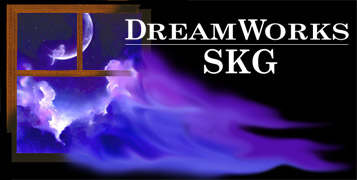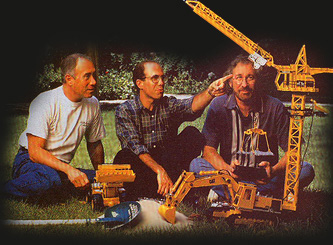

DreamWorks SKG was formed by producer and director Steven Spielberg, former Disney film executive Jeffrey Katzenberg and music industry wizard David Geffen. They joined to produce films, TV programming, interactive softwares, games and music. While the company's first spate of films did less than dreamy at the box office, DreamWorks rebounded in 1998 with such films as Deep Impact, Saving Private Ryan, Antz and The Prince Of Egypt. Principals Spielberg, Katzenberg, and Geffen each initially invested $33 million for a 22% stake apiece. Microsoft co-founder Paul Allen is DreamWorks' largest shareholder with a 24% stake of the company.
As with all aspects of Dreamworks, not everything for Playa Vista went according to plan on the first try. The studios will border protected swamp land (the Ballona Wetlands), which has caused problems with many of the area environmentalists. Eventhough agreements were made after a brief delay in 1997-1998, in mid of 1999, DreamWorks announced that they would not built a studio on the Ballona Wetlands. They cancelled their deal with Playa Vista and stated that "Playa Vista was not a final place for us. Currently Dreamworks is working out of the Amblin studios section on the Universal Pictures lot and are considering more options.
 After
seeing its plan to construct its own Hollywood studio fall apart due to
lack of financing, DreamWorks may be looking for a new cash infusion. According
to The Hollywood Reporter rumors of a mammoth merger are resurfacing. DreamWorks
reportedly was in talks with Seagram and Co. and MGM as recently as two
months ago, but those negotiations were inconclusive. Candidates now in
the running to partner with the studio are Seagram, which owns Universal
Studios and helps DreamWorks distribute its movies internationally; MGM,
which is also looking for cable distribution partners; and Vulcan Ventures,
a cable-systems company owned by Microsoft co-founder Paul Allen. DreamWorks
spokesmen have denied that any such merger plans are afoot, and the other
companies rumored to be involved have declined comment. Driving DreamWorks'
money woes is the too-pricey plan to build its studio on a 47-acre lot
of land in the Playa Vista development, near the coastal suburb of Marina
Del Rey.
After
seeing its plan to construct its own Hollywood studio fall apart due to
lack of financing, DreamWorks may be looking for a new cash infusion. According
to The Hollywood Reporter rumors of a mammoth merger are resurfacing. DreamWorks
reportedly was in talks with Seagram and Co. and MGM as recently as two
months ago, but those negotiations were inconclusive. Candidates now in
the running to partner with the studio are Seagram, which owns Universal
Studios and helps DreamWorks distribute its movies internationally; MGM,
which is also looking for cable distribution partners; and Vulcan Ventures,
a cable-systems company owned by Microsoft co-founder Paul Allen. DreamWorks
spokesmen have denied that any such merger plans are afoot, and the other
companies rumored to be involved have declined comment. Driving DreamWorks'
money woes is the too-pricey plan to build its studio on a 47-acre lot
of land in the Playa Vista development, near the coastal suburb of Marina
Del Rey.
They have already shelled out $20 million for the land but were unable
to come up with the necessary $200 million to complete the project. One
"well-placed" source for the Hollywood Reporter article claimed Spielberg
drove up the project's price by insisting on a "scenic lake and 'Cape-Cod'
style architecture." Officials for the film studio founded in 1994 by Steven
Spielberg, Jeffrey Katzenberg, and David Geffen admitted Thursday they
were scrapping plans for the Playa Vista location. Katzenberg said they
would have gone forward with the plan "only if the financial terms of the
deal make good sense for DreamWorks." Apparently they don't. DreamWorks
has been under fire from environmentalists for years because the 1,087-acre
Playa Vista development is being built in the Ballona wetlands, supposedly
home to several endangered species. The Playa Vista developers said they
still planned to construct soundstages on the site. Playa Vista President
Peter Denniston says, "Because of our great location and the continued
strength of the entertainment industry, Playa Vista will remain a focal
point for filming in Los Angeles." Spielberg issued a statement that he
and his partners still plan to build a studio and are "exploring options
for our permanent home." A likely location is nearby Glendale, where DreamWorks
has already built an animation studio and has rights to build out its 17-acre
site.

DreamWorks' 1999 performance was shattered by its earlier films like
Forces
of Nature and The Haunting. It wasn't until Fall and Christmas
when films like American Beauty and Galaxy Quest revived
Studio's reputation. Beauty brought the studio it's first Oscar
in Best Picture Category. The film earned 5 Academy Awards and earned over
$330 million in worldwide box office. While, Galaxy Quest didn't
perform solid business but was praised by critics and loved by moviegoers.
The new millenium has brought DreamWorks hits after hits. Although their first film The Road to El Dorado suffered a major loss but every film that followed (Gladiator, Road Trip, Small Time Crooks, Chicken Run, What Lies Beneath, Almost Famous, Meet the Parents, The Contender & The Legend of Bagger Vance, Cast Away, Shrek) performed well both commercially and critically.
Dreamworks Animation's fourth production pipeline in Glendale, CA enters production in early 2002 and be devoted to CG projects. The three existing production pipelines, Aardman in Bristol, England (claymation), PDI/DreamWorks in Palo Alto, CA (computer graphics) and DreamWorks traditional animation in Glendale, CA (traditional techniques), already each has the capacity to produce a major animated motion picture every 18 to 24 months.
A few weeks after the disastrous opening of Sinbad: Legend of the
Seven Seas in U.S. theaters in July 2003, head of animation Ann Daly
noted that it would be the studio's last traditionally drawn film. From
then on, DreamWorks will use computers to animate its movies. Even Jeffrey
Katzenberg concedes that the art form on which he made his reputation may
be obsolete. "I think the idea of a traditional story being told using
traditional animation is likely a thing of the past."
DreamWorks SKG
1000 Fowler Street, Glendale, CA 91201
Tel. (310) 571-2222
Tel. (818) 733-7000
www.dreamworks.com
|
||||||||||||